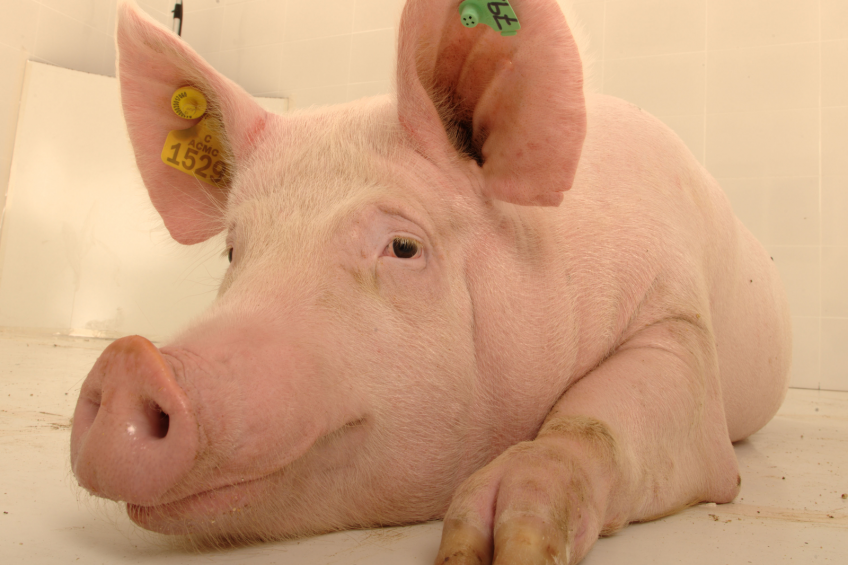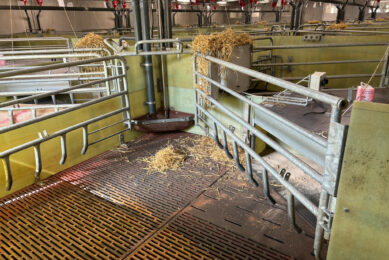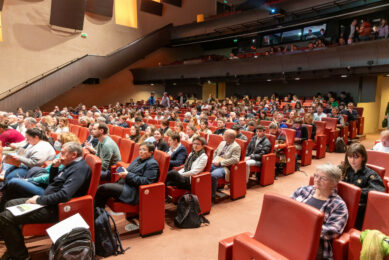There is so much more to know about sows

Defining, collecting and analysing farm data can present endless opportunities. Not only does it help to gain insight into how to improve farm management – it also helps to see correlations that otherwise would remain uncovered. Which are the quantities to really look out for?
Commonly, the number of pigs weaned per sow per year (PWSY) is used as a benchmarking measurement to compare the productivity of breeding herds amongst each other. Usually, one component of PWSY receiving a lot of focus is the number of pigs weaned, another is the number of litters per sow per year.
As this article will show, three other components deserve attention as well in this respect: the number of pigs born alive (PBA), preweaning mortality, and non-productive days (NPD) of female pigs. Assuming 30 PWSY in an example herd (Figure 1), one NPD equates 0.08 PWSY.
Non-productive days
The NPD include the weaning-to-first-mating interval, reservice interval and removal interval. Farrowing failure increases the reservice interval or removal interval and NPD. Removal includes culling, death and euthanasia.
Farrowing rate
Low or high parity sows have a low farrowing rate. For example, the highest farrowing rate is in parity 2 which is at least 5% higher than parity 0. Additionally, increased outside temperatures decrease the farrowing rate. The impact of the summer effect or outdoor temperature on reproductive performance of sows varies depending on parity number. For example, parity 1 sow farrowing rate drops by 10%, when the temperature increased from 20 to 30°C (Figure 2). In sows in parity 0 and 2 or higher, the decrease is 2-7%.
A research team at Meiji University, Japan, used 21-day preservice mean daily temperatures for individual pigs obtained from local weather stations close to the herds. This way, producers were able to predict how farrowing rates are likely to decrease by parity, based on the information from local weather news on TV.
Lower feed intake during lactation also decreases farrowing rate. This is particularly the case with parity 1 sows where low feed intake during lactation is a detrimental factor related to farrowing rate.
In addition, herds performing first insemination immediately after first detection for gilts, had a 8% higher farrowing rate than those with later times for insemination. So, insemination timing is critical for farrowing rate, especially in gilts.
Reservice interval
Approximately 10% of mated females have a return and they are reserviced. There are three types of reservice interval: regular (18-24 days), irregular (25-38 days) and late returns (39 days or later). Gilts have more regular returns than sows, and sows have more irregular returns than gilts. What follows is that gilts have a problem that is different from sows in terms of returns. The regular returns indicate either no conception or failure of maternal recognition. In contrast, irregular returns imply successful conception but subsequently early pregnancy loss and, then late returns suggest late pregnancy loss.
Additionally, 33% of the first-returned females had a second return in the same or a later parity. For example, 21% of the first-returned gilts had a second return in the same parity 0, and another 20% had a second return in a later parity from parity 1 to 6 or higher. So, to decrease non-productive days, one needs to pay attention to returned gilts and sows.
In gilts, summer servicing increases three types of returns. Also, increased gilt ages at first-mating increase late return risk. In contrast, low gilt age at first-mating increases regular returns, but not related with irregular returns.
For sows, summer servicing, lower parity, farrowing more stillborn piglets and having a WMI of seven days or more increase three types of returns. In lifetime, 33.5% of serviced females had one or more returns. These returned females had 41.5 more lifetime non-productive days than non-return females. Producers need to closely monitor females in the high risk groups to reduce their return-to-service intervals of non-productive days.

Weaning-to-first-mating interval
Parity 1 sows have prolonged weaning-to-first-mating intervals (WMI). Also, increased outside temperature increases WMI. The WMI varies depending on parity and season. As maximum temperature increased from 25 to 35°C, WMI in parity 1 sows increased by 0.8 days whereas in sows of parities 2 or higher, the increase in WMI was only 0.3 days. Parity 1 sows are three times more sensitive to high temperatures for WMI than gilts and sows in parity 2 or higher. This type of sensitivity in parity 1 sows appears to be related to their low feed intake during lactation. Like farrowing rate, low feed intake during lactation is a detrimental factor for WMI especially in parity 1 sows.
Also, the weaning-to-first mating interval can be used as a predictor for other types of reproductive performance. For example, sows with prolonged WMI will have lower farrowing rate and fewer pigs born alive. In addition, prolonged WMI is suggested to be related to a short duration of oestrus and a shorter interval between onset of oestrus and ovulation. A consequence of this is an increased risk of inseminating at a suboptimal period, which can be a major cause of low farrowing rate and fewer pigs born alive.
Removal interval
Removal interval accounts for 40% of non-productive days. Guidelines and actual culling intervals for mated sows and gilts are at least ten days higher in high-performing herds than in low-performing herds. Also, culling guidelines for mated sows and gilts are not strictly followed in any herd productivity group.
Pigs weaned per sow
The number of pigs weaned depends on the pigs born alive and the pre-weaning mortality, as can be seen in Figure 1.
Pigs born alive (PBA)
The PBA depends on the total number of pigs born, stillborn piglets and mummies. Total number of pigs born varies depending on parity and season. For example, the highest PBA is in parity 3-5 which is about 10% higher than parity 1 sows. Also, as outside temperatures increase from 25 to 30°C, total numbers of pigs born in parity 1 decrease by 0.6 pigs at their subsequent parity, whereas for pregnant gilts the decreases are only 0.2 pigs. In parity 2 or higher sows, the decrease was 0.4 pigs. So, parity 1 sows are three times more sensitive to high temperature for total number of pigs born than pregnant gilts. Again, this type of sensitivity in parity 1 sows appears to be related to low feed intake of parity 1 sows during lactation.
Delayed first-mating of gilts born in winter and spring increases the total number of pigs born alive. There is, however, only a small increase of at most 0.4 pigs, even when the gilt age increased from 200 to 300 days. So the benefit of increasing the gilt age is limited for increasing PBA. Also, no association was found between the ages and PBA for gilts born from summer to autumn. A typical approximately 240 days of age at first-mating has been practiced to increase body weights and more body reserves of replacement gilts to be first-mated.
Additionally, PBA in parity 1 is a predictor that can help producers to identify high prolific sows (super sows) at an early stage. Sows that have a high PBA in parity 1 typically produce high PBA throughout all the subsequent parities. These high prolific sows also have high lifetime reproductive performance. Gilt development is critical to have more super sows. Also, foot care for long toes or claw lesions is a good idea to keep good sows.

Pre-weaning mortality
In this decade, the number of pigs born alive has increased in many countries. Genetic improvement is a driver for increasing PBA. However, increased PBA also increases preweaning mortality. Using herd level records, risk factors are farrowing more PBA, higher parity at farrowing, summer or winter farrowing, ages of 0-1 days of lactation and longer lactation length. Trauma and low variability account for 80% of reason records for death. Recommendations for sow management are assisted-farrowing following careful management and supplemental heaters in early lactation.
Birth weight and pre-weaning growth rate
Birth weight and pre-weaning growth are not in the productivity tree. Both measurements indicate quality of piglets, and affect post weaning growth performance of piglets and subsequent reproductive performance of sows. Pre-weaning growth is affected by sow milk production, whereas lighter birth weights are associated with more pigs born in the litter. Pre-weaning growth can be increased by genetics and management tools such as use of a milk replacer and two-step nursing.
Lifetime performance
The PWSY is not the best measurement for sow lifetime performance. The lifetime performance of sows should be measured to maximise sow reproductive potentials and save resources.
Lifetime performance contains parity at removal (i.e. longevity), lifetime PBA and lifetime NPD. The lifetime NPD includes reservice interval and removal intervals which account for 70% of NPD. Also, increased mortality decreases longevity and lifetime PBA, and increases death interval and lifetime NPD.
As an integrated lifetime performance of sows, the research team has been using annualised lifetime PBA which is defined as the number of lifetime PBA divided by reproductive herd life days of the sow. The reproductive herd life days is defined as the period between the date of first mating and the date of removal of the sow. The annualised PBA indicates reproductive efficiency per year of the sow.
Mortality of gilts and sows
Increased mortality occurrences increase non-productive days and decreased numbers of pigs born alive. Farrowing is a major risk factor for sows in all parities and seasons. Approximately 68% sow deaths occurred in a six-week peripartum period. As the parity number increases, the mortality risk for sows also increases. So, parity 6 or higher sows in the peri-partum period are at the highest risk of dying. Increased care of maternal health in the peri-partum period in the farrowing barns would decrease the number of deaths of females.
In subtropical climate zones, mortality in low parity sows increases during summer, whereas in aged sows it increases during winter. For example, mortality in parity 0 and 1 sows increased 0.3% in summer, as outside high temperature increased 10°C. Also, mortality in parity 6 or higher sows increased 1% in winter as low temperature decreased 10°C.
Longevity
Longevity is typically measured as number of parity at removal. Lower longevity in sows increases costs for replacement gilts and subpopulations of parity 0 and 1 sows which have low immune status for diseases. Also, both high efficiency and longevity can be achieved in breeding herds. In herd measurements, a lower percentage of re-serviced female pigs is associated with both higher PWSY and higher parity at removal. So increasing the farrowing rate and decreasing the number of re-serviced females are the way to go.
Need for close monitoring
It is recommended that producers closely monitor the high risk female groups to reduce non-productive days and pre-weaning mortality, and increase the number of pigs born alive to improve herd productivity. Also, in most cases, reproductive performances are influenced by a set of sow factors, management factors, environment and nutritional factors depending on farms. In short – data analysis is important for each farm.
References are available on request.
Source: Pig Progress magazine. Volume 32.6 (2016)













